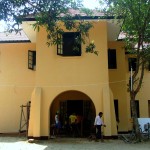As Indian Prime Minister Dr Manmohan Singh visited Burma (Myanmar) on March 3, 2014, voices for preservation of Indian testimonials in the neighbouring country also surfaced. Dr Singh was in NayPieTaw that day attending BIMSTEC (Bay of Bengal Initiative for Multi-Sectoral Technical and Economic Cooperation) summit there, where he met Burma President Thein Sein, separately.
“India and Burma should maintain cordial bilateral relationships in various sectors like tourism, IT, trade and commerce etc, but at the same time, we expect our premier should emphasis on preserving various India related heritages in Burma,” said Rupam Barua, of the Assam unit of All India Patriotic Forum.
By Nava J. Thakuria
Barua has also insisted on engaging Nobel peace laureate Daw Aung San Suu Kyi, who is now a member of Burmese Parliamentarian in the process of preserving all memorials related to India’s freedom movement, as the millions of aspiring people from both the countries fought together
against the colonial British forces from the soil of Burma.
Burma is presently changing its face from a military ruled country to a quasi-democracy and hence it starts attracting heavy investments from various western agencies in its real-estate sector. Incidentally the trend has brought worries to many patriotic Indians as well. The apprehension is that the rampant developmental activities in Rangoon (presently Yangon) may pave way for destruction of many historical ruins, including the heritage buildings related to India’s freedom struggle there. The question arises, whether the Headquarters of the Indian National Army (also known as Azad Hind Fauj) and many other monuments in the former Burmese capital can be conserved.
Formed by Indian nationalists in 1942 with the motto of Ittehad, Itmad aur Qurbani (unity, faith and sacrifice) during World War II, the Indian National Army (INA) comprised over 40,000 valiant soldiers who fought many battles against the British imperialist forces. Netaji Subhas Chandra Bose assumed the leadership of INA in 1943 and took a ground-breaking march towards Indian territories from the Burmese soil to make it independent.
When this writer visited Rangoon in 2005, the entire country was under the grip of senior general Than Shwe. The local residents were simply scared of talking about democracy, elections and even pronouncing the name of pro-democracy icon Aung San Suu Kyi. The military rulers engaged thousands of spies on the streets of Rangoon to check if anyone was revealing information about Suu Kyi, who was then under prolonged house-arrest in a two-storey lake-side
building in Rangoon.
Moreover, Suu Kyi’s father General Aung San, Burma’s independence hero, was a close friend of Netaji, the supreme commander of INA. The friendship between the two patriots was also reflected in a cordial relationship between the noble soldiers of INA and Burmese National
Army (BNA).
The military rulers, as they were always scared of Suu Kyi as a catalyst of changes in Burma, remained reluctant in paying due respect, not to speak of adoring their independence hero, who was assassinated just days before Burma got independence in 1948. As there was a hidden ban on talking about General Aung San’s daughter in public places, it had indirect negative implications on Netaji Subhas related issues.
So when this writer tried to find out the exact location and latest status of the INA building in Rangoon, my ever smiling hotel manager got confused. The local residents nearby the splendid Rangoon railway station in the down town area, where the INA headquarter is understood to
be located, were scared of talking about the building. Many, who had little understanding about the INA building and knew little Hindi or English language, simply avoided this writer with a wan smile on their faces.
Statistics reveal that the Myanmar construction industry has increased tremendously in the last few years. Supported by the improving political stability and atmosphere, the flow of foreign direct investment on various sectors like real estate, infrastructure, energy projects etc are enhanced.
Media reports suggest that there are some non-government organizations including Yangon Heritage Trust, which is trying its best to conserve Rangoon’s historic buildings from the clutches of land-grabbers. But in absence of any legal protection guideline, the trust has found it very difficult to convince the NayPieTaw based Burma government.
The local media in Burma, though slowly, starts coming out of government empowered censors’ clutches in recent time, still prefers to remain silent about any historical monuments related to INA and India’s freedom movement. No Indian newspapers or satellite news channels have full-time correspondents in Rangoon till today. So nobody knows, if at all, the INA building still exists in the historic city or has already been grabbed by the military people for sale to real-estate developers at some exorbitant high price.










